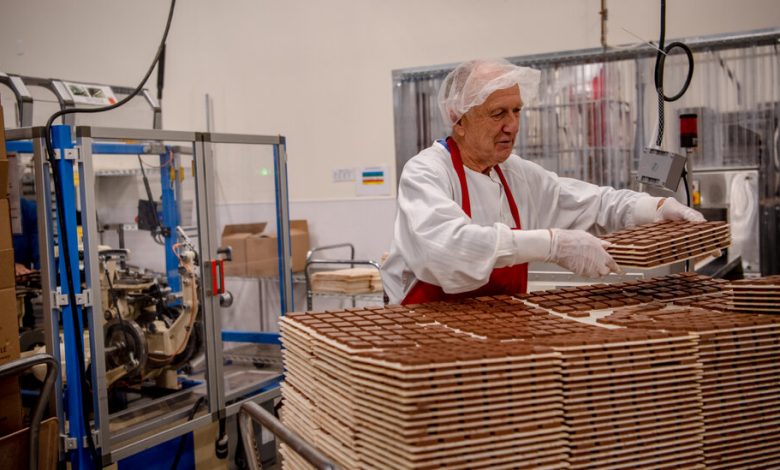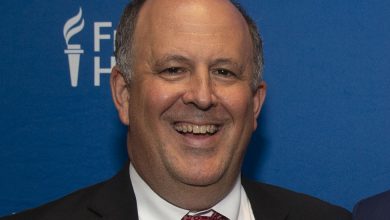Vermont May Be the Face of a Long-Term U.S. Labor Shortage

At Lake Champlain Chocolates, the owners take shifts stacking boxes in the warehouse. At Burlington Bagel Bakery, a sign in the window advertises wages starting at $25 an hour. Central Vermont Medical Center is training administrative employees to become nurses. Cabot Creamery is bringing workers from out of state to package its signature blocks of Cheddar cheese.
The root of the staffing challenge is simple: Vermont’s population is rapidly aging. More than a fifth of Vermonters are 65 or older, and more than 35 percent are over 54, the age at which Americans typically begin to exit the work force. No state has a smaller share of its residents in their prime working years.
Vermont offers an early look at where the rest of the country could be headed. The baby boom population is aging out of the work force, and subsequent generations aren’t large enough to fully replace it. Immigration slumped during the pandemic, and though it has since rebounded, it is unclear how long that will last, given a lack of broad political support for higher immigration. Birthrates are falling.
“All of these things point in the direction of prolonged labor scarcity,” said David Autor, an economist at the Massachusetts Institute of Technology who has studied long-term work force trends.

Eric Lampman, right, the president and co-owner of Lake Champlain Chocolates, has revamped its production schedule to reduce its reliance on seasonal help.
Vermont’s unemployment rate was 1.9 percent in September, among the lowest in the country, and the labor force is still thousands of people smaller than before the pandemic. Employers are fighting over scarce workers, offering wage increases, signing bonuses and child care subsidies, alongside enticements such as free ski passes. When those tactics fail, many are limiting operating hours and scaling back product offerings.
A rural state — Burlington, with a population under 45,000, is the smallest “biggest city” in the country — Vermont has for decades seen young people leave for better opportunities. And while other states have helped buttress their work forces through immigration, Vermont’s foreign-born population has remained small.
But demographics are at the root of the problem.
“We knew where we were headed — we just maybe got there a little bit quicker than we were expecting,” said Michael Harrington, the state’s labor commissioner. “There just aren’t enough Vermonters to meet the needs of our state and our employers in the future.”
There were similar shortages across the country in 2021 and 2022, as demand — for both goods and workers — surged after pandemic lockdowns. The overall labor market has become more balanced as demand has cooled and Americans have returned to the work force. But economists and demographers say shortages will re-emerge as the population ages.
“It seems to be happening slowly enough that we’re not seeing it as a crisis,” said Diana Elliott, vice president for U.S. programs at the Population Reference Bureau, a nonprofit research organization. “It’s happening in slow motion.”
Long-run labor scarcity will look different from the acute shortages of the pandemic era. Businesses will find ways to adapt, either by paying workers more or by adapting their operations to require fewer of them. Those that can’t adapt will lose ground to those that can.
“It’s just going to be a new equilibrium,” said Jacob Vigdor, an economist at the University of Washington, adding that businesses that built their operations on the availability of relatively cheap labor may struggle.
“You may discover that that business model doesn’t work for you anymore,” he said. “There are going to be disruptions. There are going to be winners and losers.”
Higher Wages, More Opportunity
The winners are the workers. When workers are scarce, employers have an incentive to broaden their searches — considering people with less formal education, or those with disabilities — and to give existing employees opportunities for advancement.
At Central Vermont Medical Center, as at rural hospitals across the country, the pandemic compounded an existing nursing shortage. An aging population means that demand for health care will only grow.
So the medical center has teamed up with two local colleges on a program enabling hospital employees to train as nurses while working full time. The hospital built a classroom and simulation lab on site, and lent out its nurses to serve as faculty. Students spend 12 of their paid working hours each week studying — and if they stay on as nurses for three years after completing the program, their student debt is forgiven.
The program has graduated 27 licensed practical nurses and eight registered nurses since 2021; some previously had administrative jobs. The hospital is expanding the training to roles like respiratory technicians and phlebotomists.
Other businesses are finding their own ways to accommodate workers. Lake Champlain Chocolates, a high-end chocolate maker outside Burlington, has revamped its production schedule to reduce its reliance on seasonal help. It has also begun bringing former employees out of retirement, hiring them part time during the holiday season.
“We’ve adapted,” said Allyson Myers, the company’s marketing director. “Prepandemic we never would have said, oh, come and work in the fulfillment department one day a week or two days a week. We wouldn’t have offered that as an option.”
Then there is the most straightforward way to attract workers: paying them more. Lake Champlain has raised starting wages for its factory and retail workers 20 to 35 percent over the past two years.
Charles Goodhart, a British economist, said the aging of the population would tend to lead to lower inequality — albeit at the cost of higher prices.
“Since the available supply of workers will go down, relative to demand, workers will demand and get higher wages,” Mr. Goodhart, who in 2020 published a book on the economic consequences of aging societies, wrote in an email.
Robots and Housing
When Walmart reached out to Cabot Creamery about increasing distribution of its Greek yogurt, Jason Martin hesitated — he wasn’t sure he could find enough workers to meet the extra demand.
Mr. Martin is senior vice president of operations for Agri-Mark, the agricultural cooperative that owns Cabot Creamery, the nationally distributed brand that employs close to 700 people in Vermont. When the company’s leadership talks about adding a product or expanding production, he said, labor is nearly always the first topic.
“As I present products to our board of directors, in the back of my mind I always think, ‘I’m going to need to find the people,’” Mr. Martin said.
The labor challenge is evident at Cabot Creamery’s packaging plant in the company’s namesake town. Blocks of cheese weighing close to 700 pounds are fed into machines that cut them, for one product, into cracker-size slices. Employees in gloves and hairnets then drop the slices into plastic pouches, which are sealed and packaged together. Many of the workers are in their 50s and 60s, and have been with Cabot for decades.
Cabot is over an hour from Burlington, in a rural area where cellphone coverage is spotty and many roads are unpaved. The county has only about 700 unemployed people, according to the state’s Labor Department, and while the company has raised pay and offers generous benefits — a recent marketing campaign cites perks including a defined-benefit pension plan, tuition reimbursement and, of course, free cheese — hiring remains difficult.
Adding to the challenge is Vermont’s housing shortage. Cabot has contracted with a local college to use unoccupied dormitories to house temporary workers brought in from other states and — on guest-worker visas — from other countries.
It is also investing in automation — not just to require fewer workers but also to make jobs less taxing for its aging employee base. New equipment will package cheese slices automatically.
To economists, investments like Cabot’s are good news — a sign that companies are finding ways to make the people they have more productive.
But ultimately, many economists say, Vermont — and the country as a whole — will simply need more workers. Some could come from the existing population, through companies’ efforts to tap into new labor pools and through government efforts to address larger issues like the opioid crisis, which has sidelined hundreds of thousands of working-age Americans.
Not all economists think aging demographics are likely to drive a national labor shortage.
The ranks of people in their prime working years was stagnant for years before the pandemic, but labor was often plentiful, said Adam Ozimek, the chief economist at Economic Innovation Group, a bipartisan public policy organization. Increased immigration, he added, would add to demand as well as supply.
Still, many economists argue that immigrants will be an important part of the solution, especially in fields, like elder care, that are rapidly growing and hard to automate.
“We need to start looking at immigrants as a strategic resource, incredibly valuable parts of the economy,” said Ron Hetrick, senior labor economist at Lightcast, a labor market data firm.
Workers Wanted
Kevin Chu has spent the past several months traveling around Vermont speaking to local business groups, elected officials, nonprofit organizations and pretty much anyone else who would listen. His message: Vermont needs more people.
Mr. Chu is the executive director of the Vermont Futures Project, a nonprofit organization, backed by the Vermont Chamber of Commerce, that sees the worker shortage as an imminent, long-term threat to the state’s economy.
Mr. Chu grew up in Vermont after his parents immigrated from China in the mid-1980s, part of a wave of immigrants — many of them refugees — who came to the state during that period. He recalls attending Burlington High School at a time when it flew the flag of its students’ home countries, dozens in all.
“I feel like I got a glimpse of what Vermont could be,” he said.
Mr. Chu’s message has resonated with business leaders and state officials, but it has been a tougher sell with the population as a whole. A recent poll found that a plurality — but not a majority — of Vermonters supported increasing the population.
The Futures Project has set a goal of increasing the population to 802,000 by 2035, from fewer than 650,000 today. That would also help bring down Vermont’s median age to 40, from 42.7.
The state has a long way to go: Vermont added just 92 people from 2021 to 2022.



